Current as of: October 6, 2025 - 21:46
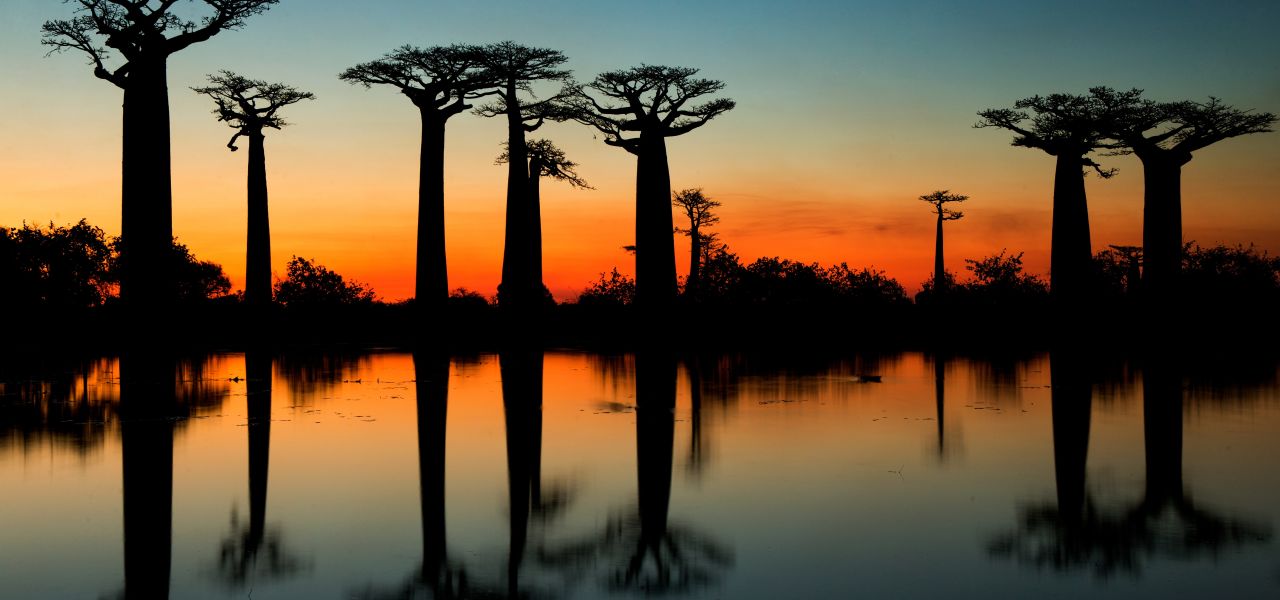
Madagascan Discoverer Trip Notes
- Ways to Travel: Guided Group
- Destination: Madagascar
- Programmes: Culture
-
Activity Level:
4 out of 7 - Moderate & Challenging
- 16 Days: Land Only
- Ages: 16+
- Trip Code: AZMA3
- Carbon Footprint: 32kg CO2e
Trip Overview
Experience the Great Red Island: the land of lemurs and breathtaking baobabs
Madagascar is home to wildlife and landscapes found nowhere else on this planet. Join this trip and discover this unique destination for yourself, visiting the primary forest at Andasibe to search for rare indri lemurs and unusual nocturnal wildlife. We also visit 1,000-year-old trees at the Alley of Baobabs, taking them in as the sunset throws an extraordinary blanket of colour, and trek through the otherworldly limestone pillars in Tsingy de Bemaraha National Park, a highlight in a trip packed full of them.
At a Glance
- Accommodation: 15 Classic nights (hotels)
- Travel by private bus, 4×4 and internal flights
- Group normally 4 to 16, plus leader. Minimum age: 16
Highlights
- Discover the highlights of Madagascar, an extraordinary island with unique flora and fauna
- Visit the Alley of Baobabs at sunset to see these unusual and ancient trees in a golden light
- Hike among the towering limestone pinnacles of Tsingy National Park
- Join experienced local trackers for the best encounters with lemurs in their natural habitats
- Explore Isalo National Park, home to amazing rock formations, spectacular canyons and natural swimming holes
- Seek unusual species, such as tenrecs, indris and sifakas, in Andasibe and Ranomafana national parks
Is This Trip for You?
This trip is graded Activity Level 4 (Moderate & Challenging). For more information on our trip gradings, visit the Activity Level Guidelines page. If you have any queries about the difficulty of the trip, please contact us.
Madagascar is a rewarding destination; however, before you decide to travel, please note:
- Madagascar is one of the poorest countries in the world and the infrastructure reflects this. The tourist infrastructure is new and some services are limited. It is not unusual for there to be changes to accommodation or internal flights and for this reason the order of the itinerary (but not the content) may change. However, what tourism does exist is of a good standard and you may be impressed by the level of service in some places we stay.
- Travelling by vehicle can be uncomfortable as road conditions are far worse than in Europe and North America. Expect many narrow, winding and uneven sections of road. Roads away from the cities and main routes are generally unpaved dirt roads, which can be very bumpy.
- We have long drives (the longest is 12 to 13 hours from Morondava to Antsirabe) but the diverse scenery more than makes up for time on the bus. Our journey times are noted in the itinerary, but these may change depending on local conditions. We break up road journeys with stops at villages to take photos and stretch our legs. Take snacks and drinks as opportunities to purchase these can be limited.
- There are many early starts and long days on this itinerary.
- Parts of Madagascar are mountainous. You need to be prepared to walk in hills for up to four hours. The trails are fairly gentle in Andasibe but steeper in the other national parks.
- Our hike in Tsingy de Bemaraha National Park takes us to the Grand Tsingy, a 3.5mi (5.6km) circular route that takes about five hours (with photo stops). It’s an adventurous hike with rock scrambling, ladders, crawling, and sliding into caves. Those who suffer from vertigo and claustrophobia may find it challenging. We also offer an easier walk to the Small Tsingy (€35) if you’d prefer.
This itinerary includes the use of pontoon ferries, which do not (typically) offer emergency safety equipment such as flotation devices. We have risk assessed these crossings and find them to be low risk. However, if you are concerned about this aspect, please consider an alternative trip as we are unable to facilitate the provision of Western safety equipment.
Water safety: This trip includes time by a lake, river or sea, where there may be opportunities to swim. You should always seek local advice before deciding whether to swim. Open-water or wild swim spots should be treated with extreme caution. Information on how to keep yourself safe while swimming is shown here.
Adult min age: 16
Min group size: 4
Max group size: 16
Itinerary
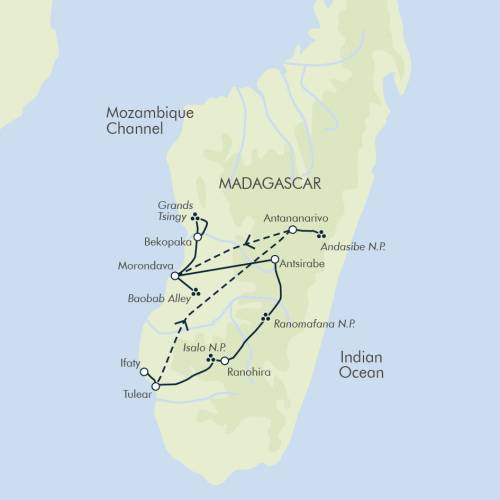
Land Only
- Start City: Antananarivo
- End City: Antananarivo
Land Only Itinerary
Our adventure starts in Antananarivo, known locally as Tana. There is a group meeting and briefing in the evening followed by an optional group dinner.
Accommodation: Hotel Belvedere (or similar)
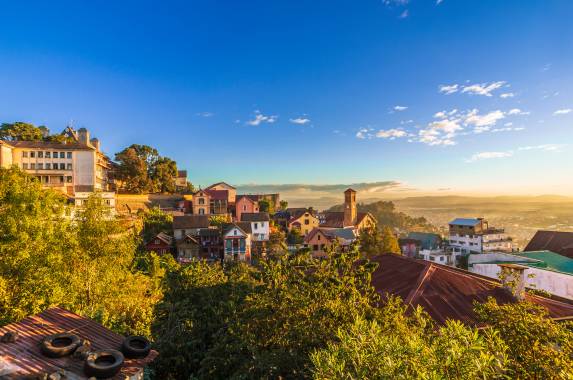
Embark on a short bus tour of Tana this morning. With bustling markets and a hilltop ancient town with freestone churches and old royal places, it is unique among world capitals.
We then drive (four to five hours, including a one-hour stop) to Andasibe, arriving around 3pm, where we visit the community-run Vondron’olona Miaro Mitia Ala Reserve. Here, we hope to see groups of the teddy bear-like indris in their natural habitat, while their white-headed relatives, diademed sifakas, jump between the treetops. There are also countless frogs along the crystalline river and several forest-dwelling chameleons.
In the early evening, we take a twilight/night walk and look for nocturnal lemur species.
Accommodation: Sahatandra River Hotel (or similar)
Explore Andasibe National Park (also known as Perinet) on a four-hour wildlife walk, which covers around 3mi (5km) with a maximum ascent of 230ft (70m). The park is home to indri, the largest lemur in Madagascar, plus other flora and fauna and a wide array of birdlife.
Listening to the piercing yet melancholy cry of the indri in the morning is an evocative sound; for those prepared to follow them through the thick rainforest, the reward is often a close-up view. A group of five diademed sifaka have recently been re-introduced to Andasibe and we may spot one of these unusual creatures if we are lucky.
We return to Tana (four to five hours, including one-hour stop) in the afternoon.
Accommodation: Hotel Belvedere (or similar)
Depart early to catch a flight west to the coastal town of Morondava, known for having one of the finest climates in Madagascar. We then pick up 4×4s in the afternoon and drive (one hour) to the Alley of Baobabs, where ancient baobab trees line an unpaved road known as the most scenic in the country.
We then drive (one hour) on a dirt road to Kirindy dry forest reserve where we spend the night.
Accommodation: Relais du Kirindy (or similar)
Visit Kirindy Reserve, home to giant jumping rats, seven lemur species and the fossa, an endemic creature that looks like a cat-weasel cross. Then we then drive (nine hours) on a dirt road to Bekopaka, passing baobab forest, which we stop to visit, desert and local villages, with a ferry crossing (one hour) over the Tsiribihina river. The western landscape is arid but beautiful.
Accommodation: Olympe de Bemaraha (or similar)
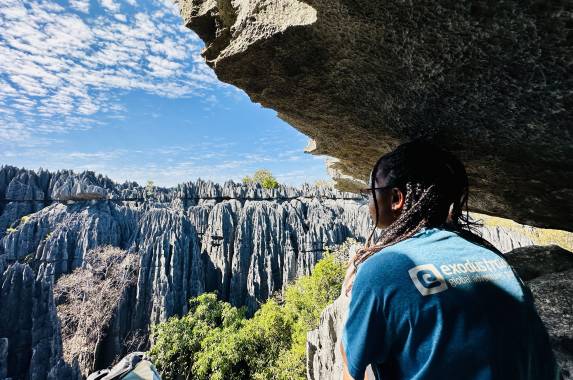
Depart early to Tsingy de Bemaraha National Park. A World Heritage site since 1990, it is best known for its forest of limestone pillars, some up to 165ft (50m) high. The karst landscape and deciduous forest are a refuge for rare and endangered species and there are more than 11 types of lemur, 90 bird species and 50 reptile species, some of which we might be lucky to spot.
Our hike takes us to the Grand Tsingy, a 3.5mi (5.6km) circular route that takes about five hours (with photo stops). We’ll hike up and downhill, over rocks, through the forest canyon, and across a hanging bridge. Along the way, we need to embrace our adventurous spirit to tackle some rock scrambling, ladders, crawling, and sliding into caves. A proper adventure! We also offer an easier walk to the Small Tsingy (€35) if you’d prefer.
In the afternoon, we head back to Bekopaka and relax at the hotel, perhaps with a swim at the pool.
Please note, while our time here is a highlight for most, it involves a demanding walk. Those who suffer from vertigo and/or claustrophobia may find parts of the trek challenging. In some places, we go through caves and narrow chasms; harnesses are used for the more challenging parts of the climb for safety reasons.
Accommodation: Olympe de Bemaraha (or similar)
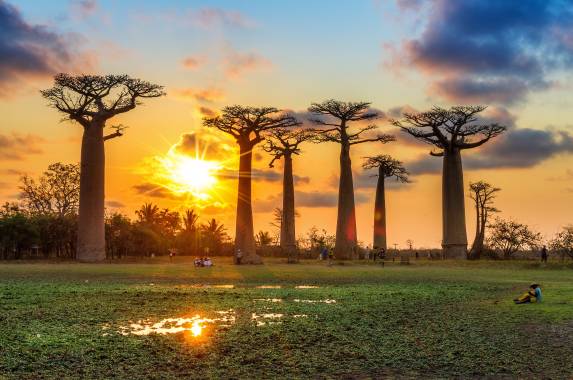
Return south after breakfast, taking 4x4s to Morondava by road (10 hours) and ferry (one hour) with plenty of stops en route. We pass by Sakalava tribe tombs along the way, known for the unusual paintings and carvings that decorate the outside of each. We stop at the Alley of Baobabs again where we plan to spend sunset. This is the best time to see these amazing trees as the colours are spectacular, a perfect photo opportunity. After sunset, we spend the night in Morondava.
Accommodation: Renala au Sable d’Or (or similar)
Today is our longest travelling day with a drive time of approximately 12 to 13 hours, including stops. We pass through the fascinating scenery of Betsiriry Plateau and the savannah plains, plus many villages along the way. We arrive by early evening. Antsirabe is at an altitude of 4,920ft (1,500m) and has a cooler climate. The warm springs and thermal baths here were a real draw in the 19th century.
Accommodation: Chambres du Voyageur (or similar)
We start with a sightseeing tour of Antsirabe, including a visit to craft centres. From here, we drive (10 hours, including stops) to Ranomafana. With rainforested hills and abundant wildlife, Ranomafana National Park has long been considered one of the highlights in Madagascar and is one of the most visited national parks in the country. The entrance lies about 4mi (7km) from Ranomafana village.
In addition to densely forested hills, the terrain is characterised by numerous small streams, which plummet to the beautiful Namorona River. Although much of the region has been logged, the easternmost part of the park retains relatively large areas of primary forest.
Accommodation: Centrest Hotel (or similar)

Spend the morning (approximately five hours) exploring Ranomafana National Park with our tour leader and a local guide, hoping to spot golden bamboo lemurs, which are unique to this park, plus other lemurs, including eastern woolly, red-bellied, grey bamboo and red-fronted brown. This park is also home to other mammals including tenrecs, bats, mongoose and the Malagasy striped civet.
In the afternoon, we visit Ranomafana village, where we see typical Tanala tribe houses and the public thermal bath.
The evening is spent on a night walk along the roads in the hope of spotting nocturnal lemurs, chameleons and other animals.
Accommodation: Centrest Hotel (or similar)
The scenery changes dramatically today as we drive to the small town of Ranohira, a journey of approximately 11 hours, including stops.
We stop in Ambalavao to visit Anja National Park along the way, a small reserve where several families of ring-tailed lemurs can be seen in the wild.
Accommodation: Isalo Ranch (or similar)
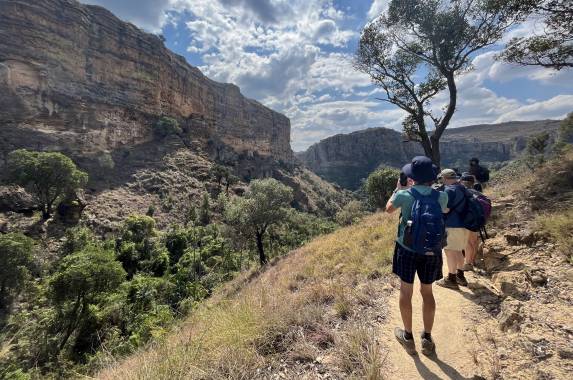
Spend the day exploring Isalo National Park, a vast region of wind-polished and water-scoured rock towers, deep canyons, gorges and oases often described as Eden. If the conditions are right, we hike in the magnificent Canyon des Makis in search of cheeky ring-tailed lemurs and the Verreaux’s sifaka.
We also visit the Piscine Naturelle (natural swimming pool), a beautifully lush spot within an arid landscape, where we can swim and relax. The combination of coloured rock formations, strange plants and enveloping silence make this one of the most captivating places in Madagascar.
Please note, Isalo is a big national park. The total hiking distance is around 5.5mi (9km) and there is some driving involved – a 4×4 transfer to the Canyon des Makis takes around 1hr 30min to two hours.
Accommodation: Isalo Ranch (or similar)
We drive to Tulear, among the dry forests of the west and the spiny desert of the south, and we pass both the Mahafaly tombs and the Antandroy tombs, briefly observing their ornate decorations. Antandroy and Mahafaly are reputed to be the most impressive of all Malagasy tombs, with the Antandroy tombs large and brightly painted, relating to the life story and wishes of the deceased. They are also topped with the skulls of zebu sacrificed during the funeral festivity, a ceremony of great significance. Mahafaly tombs are characterised by their wooden sculptures known as aloalo, relating to the life of the deceased and their unfulfilled dreams, as well as their rank within the clan. After a brief stop in Tulear, we continue past the coastal town of Ifaty to Ifaty beach where we spend the night. Our total drive time today is eight hours, including a one-hour stop.
Accommodation: Hotel de la Plage (or similar)
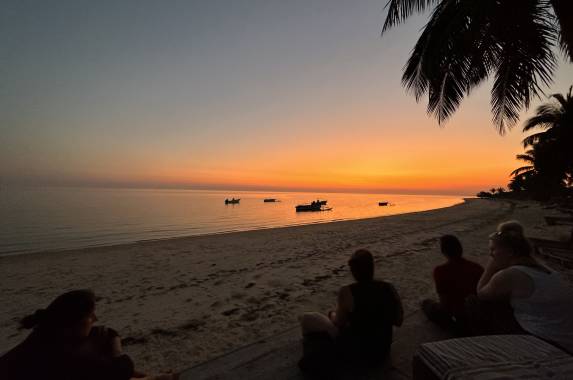
Today we have a free day. Running all the way around the southwest Malagasy coastline, Ifaty beach lies on one of the largest barrier reefs in the world and is an excellent venue for scuba diving. Between late June and early September, whales swim off the beautiful white beaches and the offshore islet of Nosy Ve is a terrific place for snorkelling. Protected by coral reefs, the beach and waters beyond the hotel offer a welcome place to rest.
Accommodation: Hotel de la Plage (or similar)
Today we transfer to Tulear airport for our flight to Antananarivo, which typically arrives in the afternoon. Depending on the flight schedule, you may have free time to explore Antananarivo on your own.
Accommodation: Hotel Belvedere (or similar)
The adventure ends in Tana today and we begin our return journeys home.
If you have time before your flight, you may wish to embark on an optional short visit to Ambohimanga, the fortified village and its royal palace. Ambohimanga, otherwise known as Blue Hills, was once forbidden to Europeans; the local kings and queens returning to this hilltop village to rest and relax. From here began the line of kings and queens who united Madagascar into one country. Ambohimanga remains of spiritual significance for the Malagasy people with ceremonies and rituals still taking place here.
Accommodation
A range of hotels
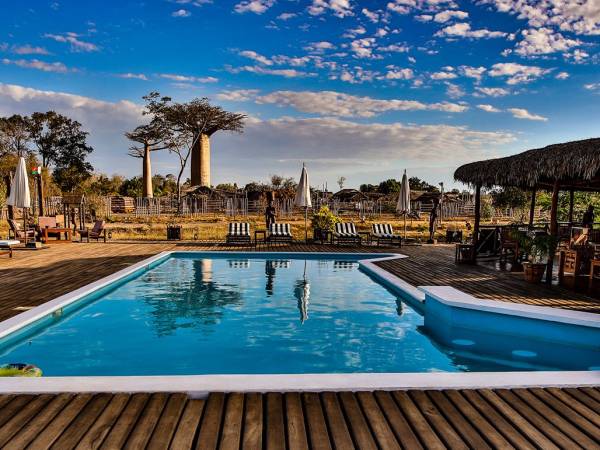
For this Madagascan adventure, we spend 15 nights in a range of hotels, each well located for our activities and in beautiful settings. Below are some of the standout accommodations.
Antsirabe: Les Chambres du Voyageur (night 8)
In Antsirabe, we stay at this husband and wife-owned hotel. They exhibit arts and crafts from the Zafimaniry ethnic group and there is a beautiful garden home to many endemic plants.
Near Isalo National Park: Isalo Ranch (nights 11-12)
This lodge close to Isalo National Park was one of the first hotels in Madagascar to run primarily on solar power. There are incredible mountain views and the owner has a collection of rhum arrange (rum with fruits, spices and herbs) that are available to sample at dinner.
Ifaty beach: Hotel de la Plage (nights 13-14)

With an enviable beachside location, Hotel de la Plage is the perfect destination for downtime following a thorough tour of Madagascar. Owners George and Myriam created this arrangement of simple bungalows by the beach and have hired helpful staff and a great chef to make their guests’ stay as comfortable as possible. Their son, Yannick, has a passion for water sports and knows the area very well.
Worth knowing
- Some properties are not connected to the electricity grid and use instead use generators that are turned off at night.
Single supplement from CAD 807
Food & Drink
Food standards in Madagascar can vary and are probably not of the same standard you are used to at home. A restaurant meal can cost between 30,000-50,000 ariary (US$7-US$12) plus a little more if you enjoy a drink with dinner. Malagasy lager is reasonably priced and readily available. Malagasy wine is also reasonably priced but is not to everyone’s taste. It is sometimes possible to get hold of French or South African wine. A delicacy in Madagascar is the various flavoured rums, which are widely sold and very reasonably priced.
Please note, if you do not eat fish or meat, your food options will be rather limited (ie omelette, cheese, pasta, vegetables and rice) on this trip. Breakfasts are usually simple: eggs, a baguette, jam and coffee or tea, and sometimes fruit. You may wish to bring something to supplement your morning meal (spread, peanut butter etc).
Transport
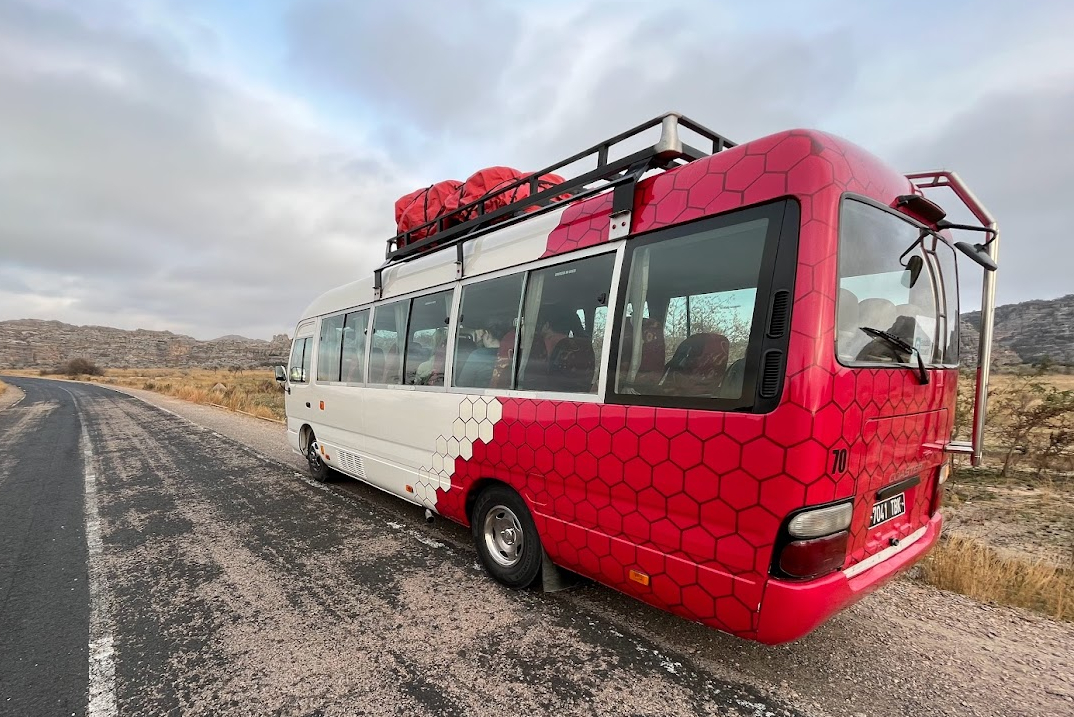
Travel is mainly by small private bus. Road conditions are far worse than in Europe and North America and you should expect many narrow, winding and uneven sections. Many of the roads away from the population centers and main routes are unpaved dirt roads which can be very bumpy. There are several days where the drives are long, with a maximum drive time of approximately 12 hours, but we make plenty of stops along the way. There are two internal flights, one from Antananarivo to Morondava and one from Tulear to Antananarivo. We also take 4×4 vehicles from Morondava to Bekopaka and back again. We use 4×4 vehicles on this section of the trip as the road is a dirt road and particularly uneven; however, the surrounding landscape and destination more than make up for it.
This itinerary also includes the use of pontoon ferries, which do not (typically) offer emergency safety equipment such as flotation devices. We have risk assessed these crossings and find them to be low risk. However, if you are concerned about this aspect please consider an alternative trip, as we are unable to facilitate the provision of Western safety equipment.
The driving distances are as follows. Approximate driving time including stops in brackets:
- Antananarivo to Andasibe: 85mi (135km); four to five hours
- Morondava to Kirindy: 37mi (60km); dirt road, two hours
- Kirindy to Bekopaka: 110mi (175km); dirt road, eight hours’ driving plus one-hour ferry crossing
- Bekopaka to Morondava: 145mi (235km); dirt road, 10 hours’ driving plus one-hour ferry crossing
- Morondava to Antsirabe: 295mi (475km); 12 to 13 hours
- Antsirabe to Ranomafana: 155mi (250km); 8 hours
- Ranomafana to Ranohira: 230mi (370km); 11 hours
- Ranohira to Ifaty: 170mi (275km); six to seven hours
Weather & Seasonality
Madagascar has a tropical climate with two seasons: rainy and dry. The driest season extends from April to October. It can be cold on the central plateau (including Antananarivo) in the evenings, and in the rainforest areas, so you should bring warm clothes (fleece and waterproof). There is considerable regional variation but coastal areas will normally be very hot and dry. Expect daytime temperatures up to 38C (100F) in the shade from October to December and up to 30C (86F) during trips running from April to June and September.
Joining Instructions
Key information
Start hotel: Hotel Belvedere, lot IF 27 bis Isoraka Tananarive 101
Phone: +261 34 79 866 38
Recommended arrival time: You can arrive at any time today. There will be a welcome briefing in the evening, but if you miss it the leader will update you separately
Airport: Ivato International Airport (TNR)
Getting to the start hotel
The start hotel is approximately 40 minutes’ drive from the airport depending on traffic. Exodus provides free arrival transfers to the start hotel from the airport for all customers. If you would like further information on joining this trip, please speak to your sales representative.
Catching your return flight
Exodus provides free departure transfers for all customers to Ivato International Airport (TNR) from the end hotel.
Please note, unless specified otherwise, the transfers will be to the start (or pre-tour) hotel and from the end (or post-tour) hotel and will be on the date on which the tour starts/ends; transfers to other hotels in the same city and/or on different dates may attract an extra charge. Transfers should be booked with your sales representative at least two weeks before the tour starts.
A day room (available from 2pm-8pm) can be requested if required. This is subject to availability at the time of booking.
Full joining instructions including local emergency numbers will be sent to you as part of our Final Joining Instructions. If you do not receive these at least a week before departure, or require them earlier please contact our office or your travel agent.
Location start: Antananarivo
Location end: Antananarivo
What To Take
Essential Equipment
- Lightweight clothing, including at least one pair of long trousers (pants) and a long-sleeved shirt (for protection against mosquitoes and scratchy plants)
- Walking boots or training shoes with good tread
- Rain jacket (needed year-round)
- Warm layers
- Warm sweater or fleece jacket (nights can be chilly)
- Sunscreen
- Sunhat
- Sunglasses
- Torch (flashlight) for use when camping, wildlife viewing at night and for power cuts
- Antibacterial gel
Internal flights in Madagascar are subject to a weight limit of 44lb (20kg) with an 11lb (5kg) limit on hand luggage.
Water included: Plastic bottles are a big issue in many countries where recycling isn’t yet widely available; they often end up in landfill or get burned. Both processes are harmful to the environment and we would like to reduce our impact here. For your trip, we provide an alternative to single-use plastic bottles to reduce the plastic used. This means that safe drinking water will be available throughout; all you need to do is bring a bottle to refill along the way. Please add this to your packing list.
Optional Equipment
- Binoculars
- Camera
- Daysack
- Swimming costume
- Earplugs if you have trouble sleeping
- Mosquito repellent
- Gloves to use in the Tsingy de Bemaraha National Park
- Walking poles
Please note, tampons are virtually impossible to get hold of in Madagascar.
Due to laws in Madagascar about the dispensing of medicine, the guides are not able to carry any basic medicines should you feel unwell. These include paracetamol, imodium and aspirin. Although they are available to buy in Madagascar, if you believe you may need these we advise you to bring them with you from home.
Practical Information
Visa
Madagascar
Visa requirements often change and it is your responsibility to obtain any required visas for this trip. Therefore, we recommend that you check with the nearest embassy or consulate of your chosen destination(s), including any countries you may be transiting or transferring through.
Some local governments provide guidance on what visas their citizens need. To help, we’ve gathered a selection of useful links below.
- Australia: www.smartraveller.gov.au/destinations/africa/madagascar
- Canada: www.travel.gc.ca/destinations/madagascar
- United Kingdom: www.gov.uk/foreign-travel-advice/madagascar/entry-requirements
- USA: www.travel.state.gov/content/travel/en/international-travel/International-Travel-Country-Information-Pages/Madagascar.html
Vaccinations and Health
Madagascar
Bilharzia is known to occur in some of the lakes or rivers visited on this itinerary, we therefore advise all to take advice from your guide or leader locally before venturing for a swim.
Local Time
Madagascar's time zone: Indian/Antananarivo (UTC +03:00)
Electricity
Madagascar's electricity: Plug types C (two round pins) and E (two round pins) – 220V, 50Hz

Money
Madagascar's currency: Malagasy ariary (MGA)
ATM Availability
ATMs are only available at the airport and in the towns of Antananarivo, Antsirabe, Morondava, Toliara and Fianarantsoa on this trip.
US dollar bills earlier than 2003 are not accepted. Malagasy ariary can also not be used at Ravinala International Airport, only euros, US dollars (later than 2003) and credit cards are accepted at the airport.
Extra Expenses & Spending Money
Visa and Mastercards can be used to obtain local currency at some banks. We advise you to bring your spending money in euros or US dollars cash as these are easiest to change to local currency. Bills of 100 euros or US dollars usually get a better rate than bills of 20 or less. British pounds can only be exchanged at some banks at the airport.
You can bring a maximum of €7,500 or the corresponding amount in other currency without declaring it on arrival, above that amount, you have to declare it. Please note that you can import and export a maximum of 400,000 ariary (around US$91).
You cannot rely on credit cards for payment as they are rarely accepted and the ATMs don’t always work; American Express or Diners cards are rarely accepted in Madagascar.
All money should be exchanged at the airport on arrival, as the process would take too long in the banks in the provincial towns. Additionally, the exchange rate at the airport is generally better than in the banks in Antananarivo or other cities. However, we recommend that you count your money by the counter and check it against the displayed exchange rate.
Any unused ariary must be exchanged before checking in for your departure.
Optional excursions (approximate prices per person):
Ifaty
- Scuba diving (single dive): 155,000 ariary (US$35.50)
- Snorkelling: 50,000 ariary (US$11.50)
- Whale watching (July-September only, minimum of four people): 140,000 ariary (US$32)
- Kayaking: 35,000 ariary (US$8)
Tipping
Our local staff are paid fairly for their work with Exodus. However, if you would like to tip your leader, we suggest approximately 11,000 ariary (US$2.50) person per day.
It is also courtesy to tip any extra guides/drivers you may have over the course of the trip. Shortly after arrival, the leader will suggest to the group that they donate a sum of 200,000 ariary (US$45) per person towards a kitty. This money is then used to tip local guides, hotel porters, drivers etc and will be distributed by the leader, avoiding confusion on how much and when to tip.
Sustainability and Impact
As a certified B Corp, we’re on a mission to improve our social and environmental impact across all our adventures.
We do this through our innovative Thriving Nature, Thriving People plan.
This ‘nature positive’ approach is designed to help nature and communities thrive in harmony through practical solutions, such as reducing carbon and waste on our trips, supporting conservation projects through the Exodus Adventure Travels Foundation, and rewilding 100 square metres for every Exodus traveller.
This trip goes near an area deemed unsafe to visit by the UK government’s Foreign, Commonwealth and Development Office, whose advice we follow when operating our trips. While our itinerary doesn’t go to these areas, you should familiarise yourself with your local government’s advice if you are planning any pre- or post-trip travel. Any independent travel to areas currently against your local government advice is entirely at your own risk and unlikely to be covered by your travel insurance.
Important Information
Your Safe Participation
When booking this trip, you should be confident in your ability to participate in all activities described in these Trip Notes. If you have any doubt about your suitability, please call us and ask to speak to one of the experts on this itinerary.
Although our leaders are well trained to deal with different capabilities, if they have any concerns about someone’s ability to safely take part in an activity, or their impact on other people’s enjoyment, we authorise them to take necessary action which, in some circumstances, may involve asking someone to miss that activity.
By booking this trip you agree to our Booking Conditions which clearly state that our leaders have the authority to do this. In these rare instances we will ensure anyone sitting out is safely provided for and offered alternative options where possible. Refunds will not be provided for activities missed and customers may be liable for additional costs incurred.
Seatbelts
All vehicles used by us should be equipped with working seatbelts, except where approved by us based on the vehicle type or journey. Wherever seatbelts are available, we require our customers to use them for their own safety, even where it may not be a legal requirement.
How to Book
Speak to our friendly team of experts to plan your adventure:
- Check availability: our website shows real-time availability or contact our team by phone, email or live chat.
- Hold a space: You can provisionally hold a space to give you time to finalise your travel plans.
- Confirm your booking: Payment of a deposit will complete your booking and secure your place on the trip.
After booking
You will receive a confirmation document and invoice, which includes extra information and guidance about your travel arrangements. Our dedicated Customer Operations team will help you with any pre-travel questions or arrangements and can easily add extensions or extra accommodation to your booking. Final Joining Instructions will usually be sent out two to three weeks prior to departure.
Adding transfers to your booking
If you have arranged your own flights and would like to add transfers to your booking, please provide your arrival and departure details to our Customer Operations team around four to six weeks before departure.
- Where free transfers are included, they are available for any flight but can only be added to your booking once we have received your flight schedule.
- Where group arrival and departure transfers are available, these operate at fixed times. You will need to arrive in time to meet the scheduled transfer. If the timings don’t align with your travel plans, our team can arrange private transfers once they receive your flight schedule.
Trip Note validity
Trip notes may be updated after booking; if any updates significantly impact the inclusions or itinerary you will be advised in writing. A link to the most up-to-date Trip Notes will be sent out with your Final Joining Instructions before departure.
The information in these Trip Notes is given in good faith. All holidays can be subject to unexpected changes, and occasionally it may not be possible to follow the itinerary as planned. In these circumstances we will make the best-possible alternative arrangements that maintain the integrity of the original itinerary.

